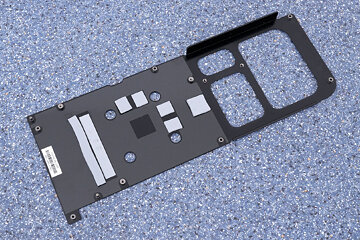 29
29
ASUS GeForce RTX 5060 Ti Prime OC 16 GB Review
Circuit Board Analysis »Packaging
The Card
I really like the ASUS Prime look for the RTX 50 Series. It's a clean design with highlights that result in a clean look that doesn't appear too plasticky. On the back you get a high quality metal backplate with a large cutout for air to flow through, the front cooler shroud is made from plastic.
Dimensions of the card are 30.5 x 12.0 cm, and it weighs 899 g.
Installation requires three slots in your system. We measured the card's width to be 51 mm.
Display connectivity includes three standard DisplayPort 2.1b and one HDMI 2.1b.
Standard for all GeForce RTX 50-series Blackwell cards is a new display engine that supports three DisplayPort 2.1b outputs, each capable of UHBR20; and one HDMI 2.1a. Both interfaces support DSC (display stream compression). With DSC enabled, a single DisplayPort on this card can drive 4K 12-bit HDR at 480 Hz; or 8K 12-bit HDR at up to 165 Hz. The RTX 5060 Ti features an updated media acceleration engine with support for 4:2:2 video formats, AV1 UHQ, and MV-HEVC. Unlike the bigger RTX 50 models, which have two, there is a single NVENC and NVDEC unit each.
The card uses a single 8-pin connector, which, theoretically allows a maximum power draw of 150 W, plus 75 W from the slot. The card's power limit is set to 180 W, with up to 198 W allowed with manual increases.
There is no lighting on the ASUS RTX 5060 Ti Prime OC.
This BIOS switch lets you toggle between the default Performance BIOS and an optional "Quiet" BIOS.
Teardown
The fan assembly can be removed easily, which makes it easy to replace a broken fan in a couple of years—no need to touch the thermal paste of the card.
ASUS has installed three heatpipes on their thermal solution, the main heatsink also provides cooling for the memory chips and VRM circuitry.
The backplate protects the card against damage during installation and handling. Note the thermal pads, which provide cooling for the memory chips on the back side of the PCB.
May 4th, 2025 18:43 EDT
change timezone
Latest GPU Drivers
New Forum Posts
- Are the 8 GB cards worth it? (834)
- RX 9000 series GPU Owners Club (633)
- Vertical mice in gaming (11)
- The TPU UK Clubhouse (26194)
- Request for advice [Big Build] (49)
- The TPU Darkroom - Digital SLR and Photography Club (4084)
- Have you got pie today? (16695)
- Technical Issues - TPU Main Site & Forum (2025) (171)
- Ai Crystal (4)
- Half Life 3 soon ? (8)
Popular Reviews
- Clair Obscur: Expedition 33 Performance Benchmark Review - 33 GPUs Tested
- ASUS ROG Maximus Z890 Hero Review
- ASUS Radeon RX 9070 XT TUF OC Review
- Montech HS02 PRO Review
- NVIDIA GeForce RTX 5060 Ti 8 GB Review - So Many Compromises
- ASUS GeForce RTX 5090 Astral Liquid OC Review - The Most Expensive GPU I've Ever Tested
- Seasonic Vertex GX 850 W Review
- Upcoming Hardware Launches 2025 (Updated Apr 2025)
- ASRock Radeon RX 9070 XT Taichi OC Review - Excellent Cooling
- Sapphire Radeon RX 9070 XT Nitro+ Review - Beating NVIDIA
Controversial News Posts
- AMD Radeon RX 9060 XT to Roll Out 8 GB GDDR6 Edition, Despite Rumors (129)
- NVIDIA Sends MSRP Numbers to Partners: GeForce RTX 5060 Ti 8 GB at $379, RTX 5060 Ti 16 GB at $429 (128)
- NVIDIA Launches GeForce RTX 5060 Series, Beginning with RTX 5060 Ti This Week (115)
- Nintendo Confirms That Switch 2 Joy-Cons Will Not Utilize Hall Effect Stick Technology (105)
- NVIDIA PhysX and Flow Made Fully Open-Source (95)
- Sony Increases the PS5 Pricing in EMEA and ANZ by Around 25 Percent (84)
- Parts of NVIDIA GeForce RTX 50 Series GPU PCB Reach Over 100°C: Report (78)
- Intel "Bartlett Lake-S" Gaming CPU is Possible, More Hints Appear for a 12 P-Core SKU (77)



















